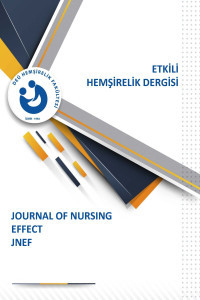Yoğun Bakım Ünitesindeki Hemşirelik İntörn Öğrencilerin Kaygı Düzeyleri
Yoğun Bakım Ünitesi, Hemşirelik Eğitimi, Hemşirelik Öğrencisi, Kaygı.
Anxiety Levels of Intern Nursing Students in Intensive Care Units
Intensive Care Unit, Nursing Education, Nursing Student, Anxiety.,
___
- Alaca, Ç., Yiğit, R., & Özcan, A. (2011). Yoğun bakım ünitesinde yatan hastaların hastalık sürecinde yaşadığı deneyimler konusunda hasta ve hemşire görüşlerinin karşılaştırılması. Psikiyatri Hemşireliği Dergisi, 2(2), 69-74.
- Başak, T., Uzun, Ş., & Arslan, F. (2010).Yoğun bakım hemşirelerinin etik duyarlılıklarının incelenmesi. Gülhane Tıp Dergisi, 52, 76-81.
- Çelik, S., & Veren, F. (2009). Türkiye’de lisans düzeyindeki hemşirelik okullarında yoğun bakım hemşireliği eğitimi. Yeni Tıp Dergisi, 26, 226-229.
- Doucette, E., Brandys, D., Canapi, B. K., Davis, A., DiNardo, J., & Imamedjian, I. (2011). The intensive care unit as an untapped learning resource: A student perspective. Dynamics, 22(1), 19–23.
- Erenel, A., Ş, Dal, Ü., Kutlutürkan, S., & Vural, G. (2008). Hemşirelik dördüncü sınıf öğrencilerinin ve hemşirelerin intörnlük uygulamasına ilişkin görüşleri. Hacettepe Üniversitesi Sağlık Bilimleri Fakültesi Hemşirelik Dergisi, 15(2), 16-25.
- Ergün, Y. A., Özer, Y., & Baltaş Z. (2001). Yoğun bakımda çalışan hemşirelerin stres düzeyleri ve stresin hemşireler üzerindeki etkileri. Yoğun Bakım Hemşireleri Dergisi, 5(2), 70-79.
- Gallagher, P. J., Rice, B., Tierney, P., Page, K., & McKinney, A. (2011). An evaluation of a critical care course for undergraduate nursing students. Nursing in Critical Care, 16, 261–269.
- Gümral, N., & Coşar, F. (2006). Ebelik ve hemşirelik son sınıf öğrencilerinin okul-hastane işbirliği ile ilgili görüşlerinin değerlendirilmesi. Süleyman Demirel Üniversitesi Tıp Fakültesi Dergisi, 13, 21- 24.
- Harrison, T. M., Stewart, S., Ball, K., & Brat, M. M. (2007). Enhancing the transition of senior nursing students to independent practice. Journal of Nursing Administration, 37, 311-317.
- Ihlenfeld, J. T. (2003). Precepting student nurses in the intensive care unit. Dimensions of Critical Care Nursing, 22, 134–137.
- Kaya H., Kaya N., Turan Y., Tan Y.M., Terzi B., Barlas D.B. (2011). Nursing activities in intensive care units in Turkey. International Journal of Nursing Practice, 17, 304-314.
- King, M. L., & Singh, M. A. (2009). Critical care bridging programme to prepare fourth year baccalaureate students for speciality practice. The Canadian Association of Critical Care Nurses, 20, 12–16.
- Orak, S., Orhan, H., Özgürce, B., & Ağırman, Ö. (2009). Süleyman Demirel Üniversitesi hastanesinde yatan hastaların bakım veren intörn hemşireler hakkında memnuniyetlerinin incelenmesi. Süleyman Demirel Üniversitesi Tıp Fakültesi Dergisi, 16(2), 1-5.
- Öner, N., Le Compte, A. (1985). Durumluk-sürekli kaygı envanteri el kitabı. İstanbul:Boğaziçi Üniversitesi Yayınları.
- Özbayır, T.,Yavuz, M., Taşdemir N, Dirimeşe E, Seki Z, Okgün A. (2011). Cerrahi hastalıkları hemşireliği intörn öğrencilerinin klinik uygulamayı değerlendirmeleri ve akademik başarı durumları. Ege Üniversitesi Hemşirelik Yüksek Okulu Dergisi, 27 (1), 1-9.
- Rattray, J. (2004). In the firing line: The nurse academic in practice. Nursing in Critical Care, 9, 95–97.21.
- Rose, L., Goldswortthy, S., O’Brien Pallas, L., & Nelson, S. (2008). Critical care nursing education and practice in Canada and Australia: A comparative review. International Journal of Nursing Studies, 45, 1103-9.
- Sabancıoğulları, S., Doğan, S., Kelleci, M., & Avcı D. (2012). Hemşirelik son sınıf öğrencilerinin intörnlük programına ilişkin görüşlerinin belirlenmesi. Dokuz Eylül Üniversitesi Hemşirelik Yüksek Okulu Elektronik Dergisi, 5 (1), 16-22.
- Swinny, B., & Brady, M. (2010). The benefits and challenges of providing nursing student clinical rotations in the intensive care unit. Critical Care Nursing Quarterly, 33, 60–66.
- Taştan, S., İyigün, E., Ayhan, H.,& Hatipoğlu, S. (2015). Experiences of Turkish undergraduate nursing students in the intensive care unit. Collegian, 22(1):117-23.
- Terzi B., Kaya, N. (2011). Yoğun bakım hastasında hemşirelik bakımı. Yoğun Bakım Dergisi, 1, 21-25.
- Tosun, N., Oflaz, F., Akyüz, A., Kaya, T., Yava, A., Yıldız, D., ve ark. (2008). Hemşirelik yüksek okulu öğrencilerinin intörn eğitim programından beklentileri ile program sonunda kazanım ve önerilerinin değerlendirilmesi. Gülhane Tıp Dergisi, 50, 164-171.
- Turgay, M. (2001). Yoğun bakım ünitesinde çalışan hemşirelerde stres. Yoğun Bakım Hemşireleri Dergisi, 5(2), 80-82.
- Williams, E., & Palmer, C. (2014). Student nurses in critical care: benefits and challenges of critical care as a learning environment for student nurses. Nursing in Critical Care, 19(6), 310-315.
- Wood, I., Douglas, J. A., & Priest, H. (2004). Education and training for acute care delivery: A needs analysis. Nursing in Critical Care, 9, 159–166.
- Yayın Aralığı: 4
- Başlangıç: 2008
- Yayıncı: Dokuz Eylül Üniversitesi Hemşirelik Fakültesi
Hemşirelerin Periferal İntravenöz Kateter Girişimlerine İlişkin Bilgi Düzeylerinin İncelenmesi
Sevgi AYDIN, Gülşah GÜROL ARSLAN
Yaşlı Kanser Hastalarında Yorgunluk
Yoğun Bakım Ünitesindeki Hemşirelik İntörn Öğrencilerin Kaygı Düzeyleri
Dilek ÖZDEN, Şerife KARAGÖZOĞLU, Fatma Tok YILDIZ
Yaşlı Bireylerde Bilişsel İşlevlerin Korunmasında ve Geliştirilmesinde Bilişsel Eğitimin Önemi
Merve Aliye AKYOL, Özlem KÜÇÜKGÜÇLÜ
Hemşirelik Bölümü Öğrencilerinin Mesleki Güdülenme Düzeyi İle Meslek Algısı Arasındaki İlişki
Hüsna ÖZVEREN, Emel GÜLNAR, Esra DOĞAN YILMAZ
Hastaların Ameliyathane Ortamına İlişkin Görüşlerinin İncelenmesi
Tuğçe YEŞİLYAPRAK, Esma ÖZŞAKER
Esra ARBAĞ, Merlinda ALUŞ TOKAT
Özge BULDAN, Nevin Kuzu KURBAN
Farklı Kronik Hastalığı Olan Bireylerin Öz-Etkililik Düzeylerinin Karşılaştırılması
